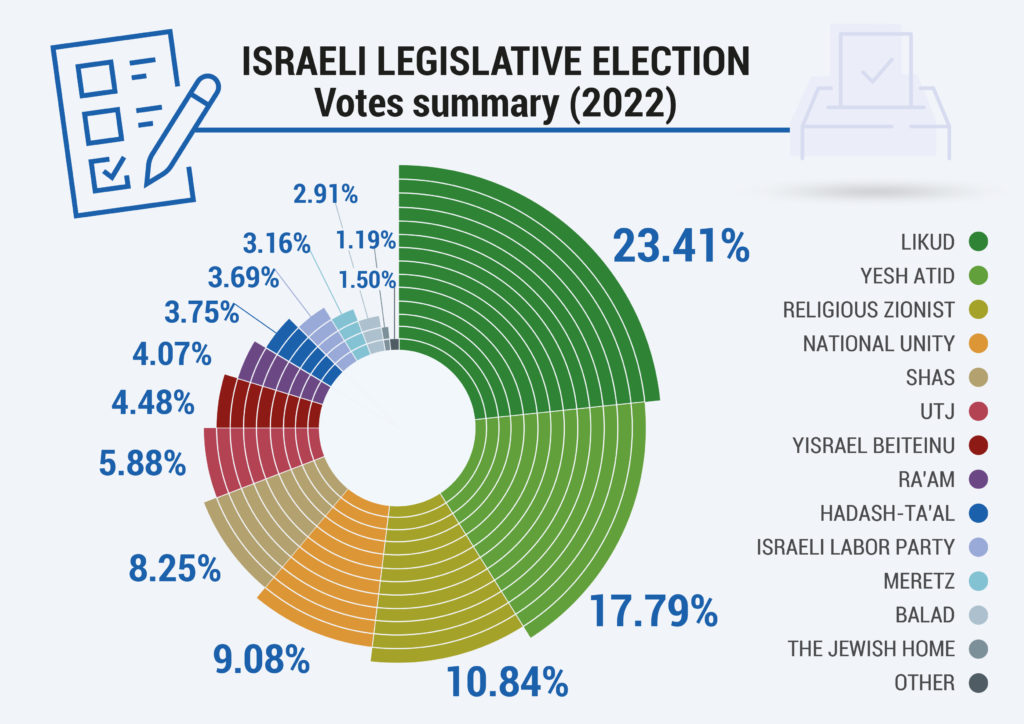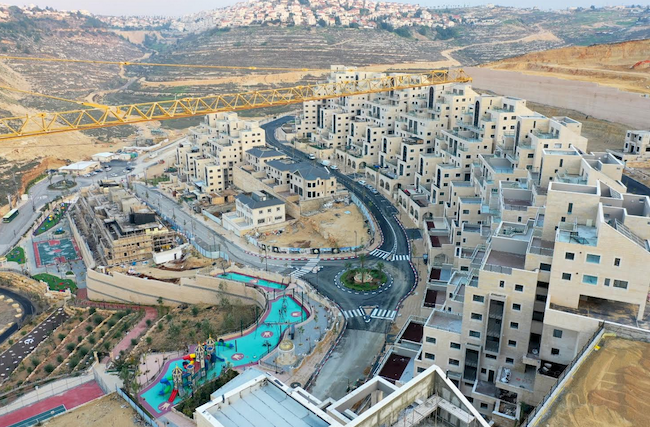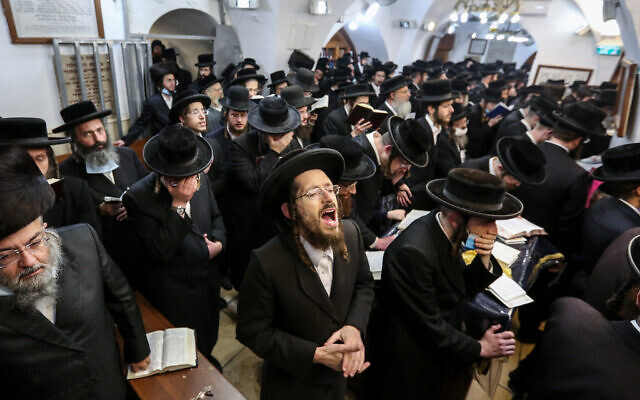Beyond the right’s breakthrough: the politics of a less liberal Israel
The recent vote in Israel for the fifth election round since 2019 could be easily read as a further twist to the right. However, its deeper meaning does not lie in the pure arithmetic of the votes, which shows a slight progression of the Religious Zionists (HaIchud ha-Leumi–Tkuma passed from 13 to 14 seats) and the biggest party, Likud (moved from 30 to 32 seats), as much as in the result of a long-term process of change launched in 1996 after the collapse of the Oslo Accords.

Netanyahu’s comeback
In politics, contingent factors do matter and two of them have greatly facilitated Benjamin Netanyahu’s victory. The 14th seat gained by the Religious Zionist Party is the outcome of its merger. This was highly incentivized and pushed forward by Netanyahu himself, by the former Naftali Bennet’s party forces Yamina, the traditional Zionist Religious constituency, now led by Bezalel Smotrich, and two smaller and far-right parties such as Otzma Yehudit (“The Jewish Pride”) of Itamar Ben Gvir and the anti-LGBTQ Noam (“Pleasantness”). They are all united in rejecting the principle of Arab-Jewish coexistence, as much as liberal rights, branded with virulence as the display of a “pernicious postmodern culture” in Noam electoral boards.

The two seats gained by Likud are, instead, an accidental gift and a consequence of the disappearance of two Leftist parties. Balad (“National Democratic Alliance”) and Meretz (“Vigour”) chose to run alone and because they avoided last-minute vote surplus agreements, they did not pass the 3.25% cut-off threshold. This led to their demise and the loss of some 300,000 votes, which were redistributed among the major parties.
The exclusion of these two parties from the Knesset implies a reduction of the number of parties represented and an overall streamlining of the whole Israeli political context. The ousting of Meretz points to the popular detachment from the single leftist Zionist party, displaying a mixed Jewish-Arab leadership and advocating full equality between Arab and Jewish citizens within the state.
The exclusion of Balad signals, instead, the demise of the Palestinian question as a territorial conflict aimed at achieving an independent nation-state by enforcing full separation between two sovereign people. In addition to these two incidental events favoring Netanyahu’s return to power, his block’s victory could be read as the relocation of some one hundred thousand votes from the political center to the religious parties, marking a long-term process fraught with consequences for the whole Middle East. The gradual, but radical evolution of Israel into an ethnic state, or a “majoritarian democracy” system, and its estrangement from liberal Western values.

From the Likud Zionism to the victory of the extreme right
The fifth electoral round in four years, the first to feature a clear and politically cohesive majority, could thus be understood as endpoint, rather than a sharp turn, of a long-term political process paving the way to the extreme right. The path to such a landing place stretches back to 1996, when Likud first came to power, overturning the very social contract at the basis of the Israeli democracy, that is an understanding of Zionism as a political movement aimed at Jewish emancipation and “normalization” of the Jewish question by the foundation of an independent State of Israel.
Since 1996, indeed, Netanyahu and his party sponsored a different version of Zionism, the Revisionist one, claiming the Mediterranean Sea and the Jordan river as the only “natural” borders of the State of Israel mentioned in the Bible (Eretz Israel). This meant no longer viewing the occupied Palestinian territories as a prospective bargaining chip in future international peace agreements (as it used to be the case with the Mifleget ha-‘Avodà – Labour leadership, under Golda Meir and Levi Eshkol’s terms), but rather as a permanent possession, simultaneously addressing the Jews’ right of return territorial quest for land and their biblical expectations.
This ideological reading of history, blended with religious beliefs, has been implemented by the Likud with some pragmatism, encouraging new settlements to flourish on a major scale all over the West Bank and ramping up the extent of colonization, while turning down formal requests to annex the occupied territories. Netanyahu, in fact, played according to international rules, fully aware of the obligations implied by the special relationship with the US, while avoiding negative reactions by powerful Sunni Arab states pleading for the Palestinian national cause, and in particular Saudi Arabia and the Hashemite Kingdom of Jordan.
Yet, the Likud strategy bets on a creeping occupation of the West Bank settlements beyond the Green Line, with the prospective goal of blurring the thin line separating pre- and post-1967 Israel and devouring as many West Bank natural and energetic resources as possible by means of formally upholding the status quo. This means a stalled condition of frozen, but low-intensity conflict, not profitable to the Palestinian general population, but justifying the survival of that hybrid body with limited sovereignty, namely self-ruling over the occupied territories as the single remnant of the 1993 Oslo Agreements, that is the Palestinian National Authority (PNA).

Israel, a Jewish country eventually
It could be argued at length on whether the same formulation of the Oslo Agreements already denied the establishment of an independent State of Palestine and its substitution with a fake semblant of autonomy, or on the ultimate goals of the then Labour Prime Minister Yitzhak Rabin. However, what is beyond question is that since 1996, the Israeli government shelved a negotiated final resolution of the conflict with the Palestinians. A simple fact that both the European countries and the USA pretended to ignore, denying that the continuous building of settlements in the occupied territories would have emptied out the possibility to build an independent Palestinian state alongside Israel according to the “two state solution”.
Read also: Israel and Palestine: mental borders, states and peoples
The Zionist Revisionist option officially adopted as a state-sponsored policy thereafter triggered the progressive distancing of the State of Israel from liberal-democratic values. This was a gradual, but irreversible parting not stemming from the country’s security context but also in the underpinning assumption, widely shared among the Jewish majority, that Israel should turn from being a country of the Jews to being a Jewish country, that is integrally Jewish in its religious practices, traditional customs and legal values. The ideal of an integral Jewish state, fully reflecting the will and the identity of the majority, reflects the switch to a majoritarian democracy, also referred to in academic literature as “ethnic democracy” (Smooha, 1997; Ghanem, 1998; Cohen-Almagor, 2021), that is an institutional system exclusively representative of and responsible to the majority.
The electoral platform of the Religious Zionists fully subscribes to this identity politics platform as both a fundamental principle and final goal: Israel is the single Jewish state on earth (as also Likud’s Eli Cohen stressed on Arutz Sheva channel during the electoral campaign) and therefore it should be a Jewish state only, despite demographic trends projecting the Arabs to be half of the population in Eretz Israel, that is between the Mediterranean Sea and the Jordan river. Within this Jewish state, all minorities – whether ethnic, religious, linguistic, or sexual ones – are allowed to prosper as long as they conform with the majority customs and habits and do not challenge majoritarian values.
The growing influence of religious parties and their constituencies
As a statement of intent, Religious Zionists listed among their priorities for the government-setting agenda the possibility to reduce judicial control of the Supreme Court over government laws and change the Court’s internal composition, to make it more subservient to political control. They also mentioned the possibility to grant immunity to soldiers deployed in counter-terrorism operations and possibly responsible for the killings of Palestinians, as well as a proposal to deport Arab-Israeli citizens, including members of the Knesset, considered disloyal to the state (such as for marking the Nakba Day, whose commemoration has been heavily constrained by the Amendment Law of the Endowments’ Budget no.40/2011, also known as “Nakba Law”). They also propose to criminalize Jewish citizens overtly critical of state policies and actions, such as the 2018 Jewish Nation-State Basic Law.
Some of these objectives have been put forward by Itamar Ben Gvir, a rising star of the extreme right but also a student of the late Rabbi Meir Kahane, elected to the Knesset in 1984 whose party – the Kach (“Thus”) – was banned in 1994 on a charge of racism after a mass killing in Hebron by one of its followers. This banning came from the Supreme Court, the same Court with which today the Religious Zionists wish to settle the score. It comes as no surprise that, 40 years down the line, a younger and more radical Religious Zionist leadership turn to the Supreme Court stigmatizing it as an alien body in Israel, being identified with a liberal values’ bulwark and, thus, perceived as increasingly distant from core Jewish national values.
Another consistent and steady trend is the demographic uptick of the haredi population. Today, it represents 12% of the population and is projected, according to the Israeli Central Bureau of Statics, to become a third of the population by 2065 (CBS projections, 21/5/2017). Simultaneously, the secular component, traditionally associated to the kibbutzim and the Zionist left, is aging and thus constantly shrinking over time. Therefore, it is no accident that Netanyahu has bet on a long-time and stable alliance with the religious parties, and in particular with the two ultra-Orthodox Shas (“Torah Guardians”) and United Torah Judaism (UTJ), which are steadily increasing their vote patterns, but are only interested in sealing off their respective communities from the wider society. The main political objectives pursued by the ultra-Orthodox parties are increasing the benefits targeting their respective communities, such as generous large families’ allowances and an independent educational system (Belz Hasidim). They also aim to continue to profit from tailored exemptions, such as opting out from “sharing the military burden” by avoiding the three-year universal military draft for males.

The two ultra-Orthodox communities, divided along ethnic and cultural lines as in Ashkenazi (UTJ) and an Oriental or Mizrahi one (Shas), used to be very moderate in foreign politics up to the mid-1990s, when they gradually embarked on a process of nationalist radicalization, particularly among the young generation, proven by the emergence of a new subgroup known as Hardalim o Torani-Leumi (Torah patriots). The latter group self-identifies as extremely conservative from the religious point of view and extremely nationalist from the political one: a radical merge between two worldviews previously perceived as being at odds with each other. The emergence of an extremely conservative and inward-looking group, breaking away from the wider society and fanning national hatred and distrust towards all non-Jews (goyyim) and even diaspora Jews (galut), does not bother Likud.
The party is only interested in securing a tactical alliance to form a cohesive government likely to pass the so-called “French Law”, that is a shield law providing a waiver for any judicial investigation to the serving prime minister while in office. A draft law has already earned the support of the three religious parties (UTJ, Shas and Religious Zionists), scarcely worried about the prime minister’s judicial troubles, whilst interested in exploiting his judicial weaknesses to extort additional political advantages, such as the West Bank formal annexation and the official erasure of the “two state solution” from the international agenda.
The marginalization of the Palestinian Arab citizens of Israel
Finally, a further trend in the long term is the increasing marginalization and stigmatization of the Palestinian Arab citizens of Israel. Even the former centrist Prime Minister Yair Lapid briefly joined the choir of the anti-Arab camp during the last electoral campaign, swearing not to include any Arab party in his future government coalition if elected. Netanyahu, who, during the 2021 electoral campaign, resorted to any means to stick to power despite his three judicial trials to the extent of reaching out to the Arabs, trying to co-opt and the Islamist Party (Ra’am) in his coalition, this time around, in the last campaign, lashed out at Arabs willing to express their vote to reunite his right-wing camp.
Read also: Israeliani, palestinesi e la convivenza (im)possibile
It is undeniable that Arab parties, too, widely contributed to in their ensuing self-defeat, for instance splitting up in three major and autonomous factions at war with each other, bringing down their collective representation at the Knesset from the 15 seats of the 2020 elections to the current 10 seats divided in half between Ra’am and the Hadash-Ta’al, the only residual block of the late Joint List. Nonetheless, for all those reasons, the Arab minority likely doomed itself to be far more disempowered, uninfluential, and helpless in Israel in the coming years.
The “two state solution” is dead
Whatever the next government’s composition, some long-run trends turn up as steady features of Israeli politics. First, the “two state solution” is dead and cannot be revived, at least not as a prospective of territorial separation heading to the establishment of two independent states as envisaged from Oslo up to Annapolis and the 2013 final round of peace negotiations brokered by the then US State Secretary Kerry. President Trump’s tenure served as a watershed to this effect: the “Deal of the Century” might not officially materialize in a short run but it is crystal-clear that the “Abraham Accords” are meant to stay as even President Biden, during his last visit in Israel in mid-July they, has hailed them as the best mean to “deepen Israel’s integration into the broader region and establish lasting ties for business, cooperation and tourism” (July 14, 2022).
Read also: Israel and the Sunni axis: a win-win alliance
Second, the Zionist left doomed itself to the utmost irrelevance in many years to being unable to upgrade its vision and overtly upheld the ideal of a binational state with full and equal rights for everyone by dropping the Zionist label. Third, the extreme right is being readmitted in the “legitimacy area” and will enjoy increasing support from now on, even advocating ideas of ethnic suprematism or religious integralism only twenty years ago deemed archaic, unacceptable and dangerous. Finally, the approval rate of the religious parties will continue unabated due to a mere demographic factor, likely to tip the balance between secular and religious Jews in the long term.
However, the cultural isolationism of both the Religious Zionists and the Ultra-Orthodox parties would likely dig a ditch between Israel and the rest of the world, self-fulfilling the old Pentateuch Balaam’s prophecy of “Israel as a country dwelling alone among the nations” (Bamidbar 23:9). Ironically, this would happen at the very historical moment when its military and political role of regional power in the Middle East is no longer denied by those same Arab neighboring countries rejecting its right to exist for so long.
Read also: Tangier and Jerusalem, a history of two attempted internationalizations
